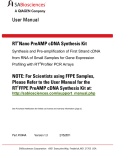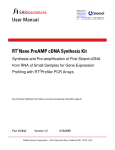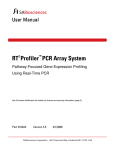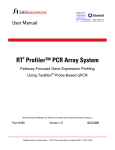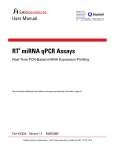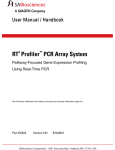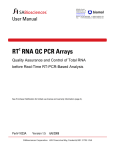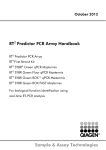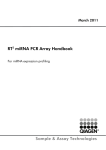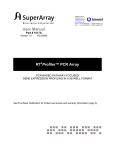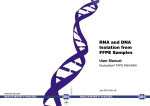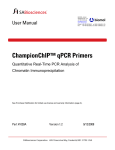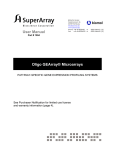Download User Manual RT FFPE PreAMP cDNA Synthesis Kit
Transcript
BIOMOL GmbH Waidmannstr. 35 22769 Hamburg [email protected] www.biomol.de Phone:+49-40-8532600 or 0800-2466651 (D) Fax: +49-40-85326022 or 0800-2466652 (D) User Manual RT2 FFPE PreAMP cDNA Synthesis Kit Synthesis and Pre-amplification of First Strand cDNA from RNA of Formalin Fixed Paraffin Embedded Samples for Gene Expression Profiling with RT2Profiler PCR Arrays See Purchaser Notification for limited use license and warranty information (page 3). Part #1046A Version 1.0 3/24/2009 RT2 FFPE PreAMP cDNA Synthesis Kit Synthesis and Pre-amplification of First Strand cDNA from RNA of Formalin Fixed Paraffin Embedded Samples for Gene Expression Profiling with RT2 Profiler PCR Arrays User Manual (For Catalog Number: C-07) Ordering and Technical Service Contact Information: • • • • Tel: Fax: On-line Order: E-MAIL: BIOMOL GmbH Waidmannstr. 35 22769 Hamburg [email protected] www.biomol.de Phone:+49-40-8532600 or 0800-2466651 (D) Fax: +49-40-85326022 or 0800-2466652 (D) 1-888-503-3187 (US) 301-682-9200 (outside US) 1-888-465-9859 (US) 301-682-7300 (outside US) www.SABiosciences.com [email protected] (to place an order) [email protected] (for technical support) You may place orders by fax, e-mail or from our website. Each order should include the following information: • • • • • Your contact information (name, phone, email address) Product name, catalog number and quantity Purchase order number or credit card information (Visa or MasterCard) Shipping address Billing address For more information, visit us at www.SABiosciences.com SABiosciences Corporation 6951 Executive Way Frederick, MD 21703 USA 2 Version 1.0 CONTENTS I. Background and Introduction 4 II. Materials Provided 6 III. Additional Materials Required 7 IV. Complementary Products 9 V. Quick Protocol 10 VI. Detailed Protocol 11 A. RNA Preparation, Quality and Amount Considerations 13 B. First Strand cDNA Synthesis 16 C. Pre-Amplification of cDNA Target Templates 17 D. Performing Real-Time PCR with RT2Profiler PCR Arrays 18 E. Data Analysis 19 VII. Alternative PreAMP Protocol for Individual RT2 qPCR Primer Assays 22 VIII. Troubleshooting and Frequently Asked Questions 25 LIMITED PRODUCT WARRANTY This product is intended for research purposes only and is not intended for drug or diagnostic purposes or for human use. This warranty limits our liability to replace this product in the event the product fails to perform due to any manufacturing defect. SABiosciences Corporation makes no other warranties of any kind, expressed or implied, including without limitation, warranties of merchantability or fitness for a particular purpose. SABiosciences Corporation shall not be liable for any direct, indirect, consequential or incidental damages arising out of the use, the results of use or the inability to use this product. NOTICE TO PURCHASER The purchase of RT2 FFPE PreAMP cDNA Synthesis Kit includes a limited, nonexclusive license to use the kit components for research use only. This license does not grant rights to use the kit components for reproduction of any primer pair mix, to modify kit components for resale or to use RT2Profiler PCR Array to manufacture commercial products without written approval of SABiosciences Corporation. No other license, expressed, implied or by estoppels, is granted. U.S. patents may cover certain isolated DNA sequences included in the RT2Profiler PCR Array. Presently, it is not clear under U.S. laws whether commercial users must obtain licenses from the owners of the rights to these U.S. patents before using RT2Profiler PCR Array. Patents are pending on the RT2Profiler PCR Array System technology itself. Technical Support: 888.503.3187 (US) 3 301.682.9200 I. Background and Introduction Annotated tissue archives with known clinical outcomes are abundant in the form of formalin fixed and paraffin embedded states. Interests in using these samples for retrospective molecular studies have grown over the past decade with the development of extraction methods to unlock nucleic acids from them. However, analysis of RNA from those samples present many challenges. The quality of RNA is often compromised during sample handling prior to fixation, formalin fixation, storage over time, and isolation procedures. RNA in FFPE samples is likely to be fragmented and chemically modified by formaldehyde with extensive cross-linking among protein, DNA and RNA. Some of those damages on RNA are irreversible and will greatly reduce the amount of templates available for interrogation, thus affecting the performance and sensitivity of gene expression measurements. In particular, FFPE RNA samples are not suitable for downstream applications that require full-length and intact RNA. Quantitative RT-PCR is the preferred method to analyze partially degraded FFPE RNA as it only interrogates a short sequence of RNA for each gene, ensuring the higher frequency of RNA fragments that contain the complete target sequence. RT2 FFPE PreAMP cDNA Synthesis Kit and Primer Mixes enhance the sensitivity of qRT-PCR in expression analysis of pathway- or disease- focused genes in partially degraded RNA from FFPE samples. Our RT2 PreAMP technology utilizes multiplex PCR-based pre-amplification to capture and amplify gene-specific cDNA target templates from FFPE samples with minimal bias. This kit is intended for synthesis followed by pre-amplification of first strand cDNA from FFPE RNA samples for gene expression analysis with our RT2ProfilerTM PCR Arrays or individual RT2 qPCR Primer Assays. You can prepare enough cDNA from each RNA sample for gene expression analysis on as many as four different pathways. Two simple steps are involved in this kit: o cDNA first strand synthesis This kit provides enough reagents for synthesizing first strand cDNA from 12 different samples. Our RT2 First Strand cDNA synthesis system in this kit comes with a built-in external RNA control template that would be detected by the Reverse Transcription Control (RTC) tests in the RT2Profiler PCR Arrays. This allows the detection of any presence of inhibitors of reverse transcription, ensuring the efficiency of the first strand cDNA synthesis reactions. o Pre-Amplification of cDNA for pathway-specific genes Each first strand cDNA synthesis reaction from 100ng to 1µg of total RNA can be amplified by 4 different sets of PCR Array-specific primer mixes, allowing gene expression analysis on as many as four different pathways. You can also create your own primer mixes using our RT2 qPCR Primer Assays with only genes that you are interested in, for up to ten targets. The Side Reaction Reducer eliminates the residual primers after pre-amplification, making the preamplified cDNA ready for PCR Array or individual qPCR assay analysis. To complete the PCR Array procedure, mix the amplified templates with one of our instrumentspecific and ready-to-use RT2 qPCR SYBR Green Master Mixes. Aliquot the mixture into each well of the same plate containing pre-dispensed gene-specific primer sets. Perform PCR, and finally, determine relative expression with your real-time instrument and the ∆∆Ct method. Important Note: Each RT2 FFPE PreAMP Primer Mix is PCR Array-specific and can only be used for the specified RT2Profiler PCR Arrays. The first strand synthesis components and the RT2 PreAMP reagents in this kit have been optimized hand-in-hand for SYBR Green real-time RT-PCR detection, further enhancing the sensitivity of our RT2Profiler PCR Arrays. The convenient and quick workflow of the RT2 FFPE PreAMP cDNA Synthesis Kit also makes this technology accessible for routine use in every research laboratory. Version 1.0 Benefits of RT2 FFPE PreAMP cDNA Synthesis Kit: Robust Performance on Partially Degraded Samples: Demonstrated to provide high performance pre-amplification without bias for FFPE samples Easy Workflow and Designed for Routine Use: Simple and quick procedures with minimal hands-on time to pre-amplify target templates under 2 hours Enhanced Gene Profiling with Superior Sensitivity: Increase the sensitivity of RT2Profiler PCR Array by 2 order of magnitude to analyze compromised RNA FFPE RNA (100ng-1µg) + GE + BC3 + RE + RI + P2 ~55 min gDNA Elimination Step First Strand Synthesis 1st strand cDNA (1/4 of RT product i.e. 5µ µL) + RT2 PreAMP PCR Master Mix ~20 min + RT2 FFPE PreAMP Primer Mix Specific for the RT2Profiler PCR Array of Your Choice PreAMP Multiplex PCR Step (8 Cycles) Amplified template ~20 min + Side Reaction Reducer Total time: <2 hr Real-time PCR Detection of 89 Gene-specific Amplification on RT2Profiler PCR Array ~2.5 - 3 hours Figure 1: Workflow of RT2 PreAMP cDNA Synthesis Procedures for FFPE Samples Technical Support: 888.503.3187 (US) 5 301.682.9200 RT2 FFPE PreAMP cDNA Synthesis Kit II. Materials Provided: This kit includes enough of the following reagents for 12 RNA samples: A. RT2 First Strand cDNA Synthesis Components (enough for 12 20-µ µl RT reactions) o One (1) tube of GE (5X gDNA Elimination Buffer) o One (1) tube of BC3 (5X Reverse Transcription Buffer 3) o One (1) tube of RE (cDNA Synthesis Enzyme Mix) o One (1) tube of RI (RNase Inhibitor) o One (1) tube of P2 (Primer and External Control Mix) o One (1) tube of RNase-free H2O B. RT2 PreAMP components o One (1) tube of RT2 PreAMP PCR Master Mix (PA-030) containing 600µ µl of 2X solution and enough for four 25-µ µl standard reactions per sample for 12 samples (48 reactions) o One (1) tube containing 96µ µl Side Reaction Reducer (SR1) enough for four standard reactions per sample for 12 samples (48 reactions) Storage Conditions: All components included in this kit are shipped on dry ice or blue ice packs and must be stored at -20 °C upon receipt. When stored properly at -20 °C, their quality is guaranteed for 6 months. Note: Ensure that you do not contaminate the 2X RT2 PreAMP PCR Master Mix and avoid repeated freezing and thawing by dividing into aliquots containing the amount of cocktail necessary for the number of reactions you are preparing each day. The rest of the cocktail should be kept in storage away from any sources of template DNA. 6 Version 1.0 III. Additional Materials Required: A. RNA Isolation Kit: See Page 13 for specific recommendations. B. For Gene Expression Analysis using RT2 Profiler PCR Arrays a. RT2 FFPE PreAMP Primer Mix (PFH-XXXX, PFM-XXXX, PFR-XXXX): MANDATORY for a Successful and Unbiased Pre-Amplification of your samples—each primer mix is specific to a cataloged RT2Profiler PCR Array. Check the label to verify that you have the correct pathway-specific RT2 PreAMP Primer Mix for the PCR Arrays you are performing. Please also verify that the lot number of your Primer Mix is compatible with that of the RT2 Profiler PCR Arrays you are going to use. We strongly recommend the Primer Mix and the PCR Arrays to be purchased together whenever possible. If the Primer Mix and the PCR Arrays have been purchased at different times, please check with our Customer service (1-888-503-3187) to ensure their compatibility b. SABiosciences RT2 Profiler PCR Array: The PCR Arrays are available in six different plate formats, each tailored to a specific subset of real-time PCR instruments and associated blocks. Formats A, C, D, and F are 96-well plates, while Formats E and G are 384-well plates. Technical Support: 888.503.3187 (US) 7 301.682.9200 RT2 FFPE PreAMP cDNA Synthesis Kit Format: For Real-Time Instruments: Plate: A All ABI “standard” blocks (7000, 7300, 7500, 7700, 7900) Bio-Rad iCycler, MyiQ, iQ5 Bio-Rad (MJ Research) Chromo 4 Eppendorf RealPlex Stratagene Mx3005p, Mx3000p 96-well C ABI 7500 and 7900HT FAST 96-well blocks ABI StepOnePlus™ 96-well D Bio-Rad CFX96 Opticon and Opticon 2 (MJ Research) Stratagene Mx4000 96-well E ABI 7900HT 384-well block 384-well F Roche LightCycler 480 96-well block 96-well G Roche LightCycler 480 384-well block 384-well NOTE: The format of the PCR Array is indicated by the last letter of the catalog number. Be sure that you have the correct PCR Array format for your instrument before starting the experiment. The 96-well PCR Arrays (Formats A, C, D, and F) are shipped in sets of two (2) or twelve (12), while the 384-well PCR Arrays (Formats E and G) are shipped in sets of four (4). Each PCR Array shipment includes the arrays and either twelve (12) optical thin-wall 8-cap strips (Formats A and D) or one (1) optical adhesive film (Formats C, E, F, and G) per array. 8 Version 1.0 OR C. RT2 qPCR Primer Assay(s) (PPH-XXXXX, PPM-XXXXX, PPR-XXXXX): To make your own primer mix for up to 10 individual genes of your choice, order the RT2 qPCR Primer Assays specific to your selected genes and species form our catalog. Follow the instructions on “Alternative PreAMP Protocol for Individual Primer Assays” on page 22 to make the primer mix and perform qPCR Assays. D. SABiosciences RT2 qPCR Master Mix MANDATORY for a Complete and Successful Experiment Be sure to pick the correct one for the instrumentation in your laboratory. 1. 96-Well PCR Arrays RT2 SYBR Green / ROX qPCR Master Mix: Specifically designed for: All ABI and Stratagene Instrumentation Eppendorf Mastercycler® ep realplex Instruments with ROX filter set Catalog Number Size PA-012 For 2 RT2Profiler PCR Arrays PA-012-12 For 12 RT2Profiler PCR Arrays PA-012-24 For 24 RT2Profiler PCR Arrays RT2 SYBR Green / Fluorescein qPCR Master Mix: Specifically designed for BioRad iCylcer®, MyiQ®, and iQ5 Instrumentation Catalog Number Size PA-011 For 2 RT2Profiler PCR Arrays PA-011-12 For 12 RT2Profiler PCR Arrays PA-011-24 For 24 RT2Profiler PCR Arrays RT2 SYBR Green qPCR Master Mix: Specifically designed for instrumentation that does not require a reference dye: BioRad (MJ Research) Opticon, Opticon 2, and Chromo 4 Roche LightCycler® 480 System Eppendorf Mastercycler® ep realplex Instruments without ROX filter set Catalog Number Size PA-010 For 2 RT2Profiler PCR Arrays PA-010-12 For 12 RT2Profiler PCR Arrays PA-010-24 For 24 RT2Profiler PCR Arrays 2. 384-Well PCR Arrays Each 384-well PCR Array 4-pack (Formats E & G) requires four (4) of the smaller size of the correct master mix for your instrument (4 X PA-01#). Technical Support: 888.503.3187 (US) 9 301.682.9200 RT2 FFPE PreAMP cDNA Synthesis Kit E. Equipments: 1. A conventional programmable thermal cycler with 0.2mL tube heat block, heated lid and 10-100 µL reaction capacity. 2. For recommendations on specific real-time instrumentation (thermal cyclers with fluorescent detection), see the list of master mixes and plate formats above. NOTE: The PCR Arrays can only be used in 96-well and 384-well real-time PCR instruments. PCR Arrays can not be used in the Cepheid SmartCycler®, the Roche LightCycler® 2.0, or the Corbett Research Rotorgene. 3. 4. 5. 6. 0.2 mL individual or 8-tube strip PCR tubes with caps Calibrated P2, P20, P200 and P1000 Single Channel Pipettors Calibrated Multi-Channel Pipettor RNase / DNase-free pipette tips and tubes IV. Complementary Products: XpressRef™ Universal Total RNA: Universal RNA to control PCR conditions is available from the following species: Human XpressRef™ Universal Total RNA Mouse XpressRef™ Universal Total RNA Rat XpressRef™ Universal Total RNA 10 (Cat. No. GA-004) (Cat. No. GA-005) (Cat. No. GA-006) Version 1.0 V. Quick Protocol: 2 1. Before starting the experiment, make sure both the pathway and the lot number of your RT FFPE 2 PreAMP Primer Mix are compatible with those of your RT Profiler PCR Array (Refer to page 4 and page 11 for details). 2. Perform first strand cDNA synthesis as follows: Add 2 µl of GE to 8 µl of RNA (100ng -1µg). Incubate at 37°C for 15 min and immediately chill on ice. Mix a master mix for the RT reaction as below: For 1 reaction: BC3 4 µl RE 1 µl RI 1 µl P2 1 µl RNase-free H2O 3 µl Add 10 µl of the RT master mix to 10 µl GE-treated RNA. Incubate at 37°C for 30 min and heat at 95°C for 5 min. Chill on ice or store at -20°C until use. 3. For the normal standard reaction, mix the following components in a PCR tube: 2 12.5 µl 2X RT PreAMP PCR Master Mix (PA-030) 2 2 7.5 µl RT FFPE PreAMP Primer Mix specific for the RT Profiler™ PCR Array of your choice 5.0 µl undiluted cDNA template of the 20-µl first strand synthesis reaction from Step 2 25.0 µl final volume 4. Perform 8 cycles of PCR in a thermal cycler: NOTE: The 10-min step at 95 °C is required to activate the HotStart Taq DNA polymerase. 95 °C, 10 min; 8 cycles of (95 °C, 15 sec; and 60 °C, 2 min); 4 °C forever 5. Add 2 µl of the Side Reaction Reducer (SR1) to each pre-amplified reaction, and incubate at 37 °C for 15 min followed by heat inactivation at 95 °C for 5 min. 6. Dilute the 27-µl pre-amplified templates to 111 µl by adding 84 µl of RNase/DNase free H2O. Use 2 immediately and keep on ice prior to loading onto the RT Profiler™ PCR Array or store at -20°C until use. 2 7. For use in the RT Profiler TM PCR Array, mix well the following components in 15-mL conical tube: 2 1275 µl 2X SABiosciences RT qPCR SYBR Green Master Mix (Note: Use the appropriate master mix specific for your real-time PCR instrument) 102 µl diluted PreAMP PCR reaction (from Step 6) 1173 µl RNase/DNase free H2O 2550 µl final volume 8. Add 25 µl of the above Experimental Cocktail to each well of the PCR Array, preferably from a reservoir with an eight-channel pipettor (or a twelve-channel pipettor but only using eight tips). 9. Run the following real-time thermal cycler program: NOTE: The 10-min step at 95 °C is required to activate the HotStart Taq DNA polymerase. 95 °C, 10 min; 40 cycles of (95 °C, 15 sec; and 60 °C, 60 sec) 10. Program the real-time thermal cycler to detect and record the SYBR® Green I signal from every reaction during the annealing step of each cycle. Technical Support: 888.503.3187 (US) 11 301.682.9200 RT2 FFPE PreAMP cDNA Synthesis Kit VI. Detailed Protocol: Please read through this entire protocol before beginning your experiment. RNA samples are very sensitive to RNase digestion; therefore, wear gloves and maintain an RNase-free work area while performing this protocol. Important Note: Please note that each RT2 FFPE PreAMP Primer Mix is specific to a catalogued RT2Profiler PCR Array and can only be used for the intended PCR Array. Please also verify that the lot number of your Primer Mix is compatible with that of the RT2Profiler PCR Arrays you are going to use. Otherwise, the PreAMP process may not work optimally. If the Primer Mix and the PCR Arrays have been purchased at different times, please check with our Customer service (1-888-503-3187) to ensure their compatibility. NOTE: Master Mix and First Strand Synthesis Considerations The performance of our RT² FFPE PreAMP cDNA Synthesis Kit is only guaranteed with our RT2 FFPE PreAMP Primer Mix and our RT²Profiler PCR Arrays and RT2 qPCR SYBR Green Master Mixes. In addition, the RT2 PreAMP PCR Master Mix in this kit is specially formulated for multiplex PCR-based pre-amplification with our RT2 FFPE PreAMP Primer Mix for optimal results without introducing bias. The chemically-modified and tightly controlled HotStart enzyme and other proprietary chemical components in our RT2 qPCR Master Mixes uniquely provide more accurate SYBR Green results by preventing the amplification of primer dimers and other nonspecific products. They also help ensure high amplification efficiencies even for those genes that are the most difficult to amplify. When we test other sources of enzymes with our PCR Arrays, we frequently see primer dimers and other non-specific products that confound SYBR Green-based real-time PCR detection. Because each instrument uses a different reference dye to normalize their optics, be sure that you use the correct master mix for the instrumentation in your laboratory. Our RT2 First Strand cDNA Synthesis components in this kit include a proprietary buffer to eliminate any residual genomic DNA contamination in your RNA samples before it can be amplified into secondary products that would otherwise cause false positive signals. The Reverse Transcription Controls (RTC) on our RT2Profiler PCR Array can only be evaluated with the built-in external RNA control of our RT2 First Strand cDNA Synthesis components. These controls do not yield results when used with other sources of reverse transcriptases or first strand synthesis kits. The buffer components and the magnesium concentration in our RT2 First Strand cDNA Synthesis components are also more compatible with our RT2 PreAMP PCR and RT2 qPCR master mixes than other enzymes or kits, providing the PCR Arrays with maximum levels of sensitivity. 12 Version 1.0 NOTE: Preparing a Workspace Free of DNA Contamination For accurate and reproducible PCR Array results, it is very important to avoid contamination of the assay with foreign DNA. Any DNA contamination will artificially inflate the SYBR Green signal yielding skewed gene expression profiles and false positive signals. The most common sources of DNA contamination are the products of previous experiments spread into the air of your working environment. Please follow the recommendations below on how to set up and maintain a working environment free of DNA contamination. 1. Wear gloves throughout the procedure. Use only fresh PCR-grade reagents (H20) and lab ware (tips and tubes). 2. Physically separate the workspaces used for PCR setup and post-PCR processing or non-PCR operations. Decontaminate your PCR workspace and lab ware (pipettor barrels, tube racks, etc.) before each new use with UV light to render any contaminating DNA ineffective in PCR through the formation of thymidine dimers or with 10% bleach to chemically inactivate and degrade any DNA. 3. Close all tubes containing PCR products once you are finished adding or removing volumes. Before discarding any lab ware (tips or tubes) containing PCR products or other DNA, treat with 10% bleach. 4. Do not remove the PCR Array plate from its protective sealed bag until immediately ready to use. Do not leave lab ware (tubes and tip boxes) exposed to the air for long periods of time. 5. Do not open any previously run and stored PCR Array plate. Removing the thin-wall 8cap strips or the adhesive film from PCR Arrays releases PCR product DNA into the air where it will contaminate and confound the results of future real-time PCR experiments. Technical Support: 888.503.3187 (US) 13 301.682.9200 RT2 FFPE PreAMP cDNA Synthesis Kit A. FFPE Sample Preparation, RNA Preparation, Quality and Amount Considerations Good quality RNA is ESSENTIAL for obtaining good real-time PCR results. FFPE samples are amongst the most difficult RNA samples to work with due to the existence of degradation and chemical modifications in those types of samples. To obtain the best possible RNA quality from FFPE samples, the sample handling and RNA isolation procedures are critical. With any isolation methods, it is important to remember that the presence of residual traces of proteins, salts or other contaminants will either degrade the RNA or decrease the efficiency of (if not block completely) the enzyme activities necessary for optimal reverse transcription, PreAMP PCR and real-time PCR performance. 1. FFPE Sample Preparation for Gene Expression Analysis: The quality of the RNA isolated from FFPE samples will depend on the technique used to execute the archiving procedure and may depend on the age of the block and other less tangible variables (1). Standard fixation recommendations for the eventual purposes of gene expression analysis call for fixing tissue samples of thickness no more than 5 mm for 14 to 24 hours in 4 to 10% neutralized formalin as quickly as possible after surgical removal. Longer fixation times and longer periods of time from surgery to fixation lead to more severe RNA fragmentation and chemical modification, resulting in poor performance in downstream assays. It is also highly recommended to completely dehydrate the samples prior to embedding in paraffin. Previously archived samples may not have been processed in this fashion, and the details of how the process was actually performed may not be available. However, with appropriate FFPE RNA isolation procedures which can effectively reverse chemical cross-linking, gene expression analysis may still be performed. 2. Recommended RNA Preparation Methods: For best results, use SABiosciences’ RT2 FFPE RNA Extraction Kit (Catalog # PF023). The RT2 FFPE RNA Extraction Kit uses an optimized RNA isolation protocol that reverses more cross-links than other methods and removes salts, metabolites, and macromolecular cellular component and other contaminants that would otherwise inhibit the qRT-PCR processes, making RNA more available and ready for cDNA template synthesis and qRT-PCR. We have tested a few other commercial FFPE RNA isolation kits including those from Ambion and Qiagen which may also provide similar RNA quality. In addition, minimizing or eliminating genomic DNA contamination is essential for obtaining optimal gene expression profiling results from real-time PCR. No currently available purification method can guarantee that RNA is completely free of DNA, even when it is not visible on an agarose gel. Trace amounts of DNA may still remain after the RT2 FFPE RNA Extraction procedure. You may treat your RNA sample after isolation with a good source of RNase-free DNase followed by re-purification of the RNA. We currently recommend TURBO DNA-free™ kit from Ambion (Catalog #1907). In addition, the gDNA Elimination Buffer (GE) in this kit will help remove any and all residual contamination from your RNA samples. An 14 Version 1.0 appropriately performed “no reverse transcription” (NRT) control during real-time PCR is then the best and most accurate test for genomic DNA contamination and should yield real-time Ct values greater than 35 (without PreAMP process). If these Ct values are less than 35 (without PreAMP process), then genomic contamination is still apparent. For the optimal performance of RT2 FFPE PreAMP cDNA Synthesis procedures and best results from the PCR Array, all RNA samples should be suspended in the RNase-free water provided with the RT2 FFPE RNA Extraction Kit. DO NOT use DEPC-treated water! 3. RNA Quality Control: All RNA samples should also demonstrate consistent quality according to the following criteria: a. RNA Concentration and Purity by UV Spectrophotometry NOTE: Prepare dilutions and measure absorbance in 10 mM Tris, pH 8.0 buffer. The spectral properties of nucleic acids are highly dependent on pH. i) A260:A230 ratio should be greater than 1.7. (A low 260/230 ratio indicates possible salt or guanidine contamination.) ii) A260:A280 ratio should be from 1.8 to 2.2. (A low 260/280 ratio indicates possible protein contamination.) iii) Concentration by A260 should be greater than 12.5 ng/µl total RNA b. Ribosomal RNA band integrity RNA from archived tissues samples is expected to show some degree of degradation. Electrophorese a fraction of each RNA sample on a denaturing agarose gel, or alternatively, characterize the samples with a NanoChip 6000 on an Agilent BioAnalyzer. Assess the extent of RNA degradation; the usual length of FFPE RNA fragments is expected to be between 100 to 1000 bases. Because some contaminants are difficult to detect by simply looking at RNA integrity and can be missed by UV spectrophotometry, it is essential to choose the proper RNA isolation method for your biological sample as described above. c. The RT2 RNA QC PCR Array (Optional): The RT2 RNA QC PCR Array and the RT2 First Strand Kit (each sold separately) test for a number of RNA quality control parameters including: • • • High and low housekeeping gene expression levels Reverse transcription and polymerase chain reaction efficiency Genomic and general DNA contamination Technical Support: 888.503.3187 (US) 15 301.682.9200 RT2 FFPE PreAMP cDNA Synthesis Kit The RNA QC PCR Arrays are particularly useful for researchers who are unsure of their RNA isolation technique. Follow the recommendations for the use and interpretation of the RT2 RNA QC PCR Array found in its User Manual. 4. Amount Considerations: The RT2 FFPE PreAMP cDNA Synthesis Kit generates sufficient templates for gene expression analysis in RT2Profiler PCR Arrays with as little as 100 ng or as much as 1 µg total RNA input into each first strand cDNA synthesis reaction prior to preamplification step. Each RT reaction allows the user to perform as many as four RT2 PreAMP PCR reactions and four RT2Profiler PCR Arrays. However, the optimal amount of starting material depends on the relative abundance of the transcripts of interest. Lower abundance transcripts require more RNA; higher abundance transcripts require less RNA. Greater amounts of input total RNA yield a greater number of positive calls; that is, genes expressed in the linear dynamic range of the method. Lower amounts of input total RNA yield a smaller number of positive calls and increase false negative calls. The RT2 First Strand cDNA Synthesis components in this kit are optimized for the subsequent RT2 PreAMP procedures and maximizes the number of positive calls at low amounts (100 ng) of total RNA. For successful results and maximum positive call rates, we recommend that first-time users try starting with around 500 ng of total RNA. It is also important to use a consistent amount of total RNA for all samples in a single experiment to be characterized and compared. 16 Version 1.0 B. First Strand cDNA Synthesis NOTE: The use of RT2 First Strand cDNA Synthesis Components in this kit is critical for successful pre-amplification of templates for the RT2Profiler PCR Arrays and detecting the Reverse Transcription Controls (RTC) in the PCR Arrays. For more information on the importance of these components, refer to the notes found on Pages 11 and 15. NOTE: RNA samples must meet the standards of integrity and purity from protein, organics, and genomic DNA contamination described on the previous three pages. 1. Clean up RNA by eliminating genomic DNA contamination: a. For each RNA sample, combine the following in a sterile PCR tube: Genomic DNA Elimination Mixture Total RNA GE (5X gDNA Elimination Buffer) RNase-free H2O Final Volume 1 reaction 100 ng to 1 µg 2 µl Varied 10 µl NOTE: Use the similar amount of total RNA in this reaction for every sample. First-time users are recommended to start with 500 ng of total RNA. Lower amounts of total RNA than 100 ng will dramatically affect the performance of the pre-amplification process. b. Mix the contents gently with a pipettor followed by brief centrifugation. c. Incubate at 37 °C for 15 min. d. Chill on ice immediately for at least one minute. 2. Prepare the RT Cocktail: RT Cocktail BC3 (5X Reverse Transcription Buffer 3) P2 (Primer & External Control Mix) RE (cDNA Enzyme Synthesis Mix) RI (RNase Inhibitor) RNase-free H2O Final Volume 1 reaction** 4 µl 1 µl 1 µl 1 µl 3 µl 10 µl **Scale up the volume for each of the RT Cocktail reagents accordingly when multiple reactions are carried out to minimize pipetting variations. 3. First Strand cDNA Synthesis Reaction: a. Add 10 µl of RT Cocktail from Step B.2 to each 10-µl Genomic DNA Elimination Mixture from Step B.1. b. Mix well but gently with a pipettor. Spin the tubes briefly to remove any air bubbles and collect all the liquid to the bottom. c. Incubate at 37 °C for exactly 30 min and then immediately stop the reaction by heating at 95 °C for 5 minutes. d. Hold the finished First Strand cDNA Synthesis Reaction on ice until the next step (Step C) or store overnight at -20 °C. Technical Support: 888.503.3187 (US) 17 301.682.9200 RT2 FFPE PreAMP cDNA Synthesis Kit C. Pre-Amplification of cDNA Target Templates: NOTE: The use of SABiosciences’ RT2 FFPE PreAMP Primer Mix (Cat. No. PFH-XXXX, PFM-XXXX, PFR-XXXX) is critical for a successful multiplex PCR pre-amplification of your cDNA and for obtaining the best results from the PCR Array. Be sure to check the label to verify that you have the correct pathway and lot number of the RT2 FFPE PreAMP Primer Mix for the PCR Arrays you are performing. (See pg 4 and pg 11 for details) NOTE: The accuracy and precision of your pipetting determine the consistency of your results. Be sure that all of your micro-pipettors are calibrated before beginning this procedure. Also, make sure to not introduce any bubbles into the wells of the PCR tubes. 1. Thaw the RT2 PreAMP PCR Master Mix (PA-030) and RT2 FFPE PreAMP Primer Mix at room temperature. If precipitates are observed, warm the reagents at 42°C for 1 min and vortex briefly to dissolve. Repeat the process if necessary. 2. Prepare the PreAMP PCR Cocktail: RT2 PreAMP PCR Cocktail RT2 PreAMP PCR Master Mix (PA-030) (2X Solution) RT2 FFPE PreAMP Primer Mix (each specific for a RT2Profiler PCR Array) Final Volume 1 reaction** 12.5 µl 7.5 µl 20 µl **Scale up the volume for each of the PreAMP PCR Cocktail reagents accordingly when multiple reactions are carried out to minimize pipetting variations. 3. PreAMP PCR Reaction: a. Pipet 5 µl of the First Strand cDNA Synthesis Reaction from Step B.3 into a 0.2ml PCR tube. Then add 20 µl of the PreAMP PCR Cocktail (from Step C.2). b. Mix well but gently with a pipettor. Spin the tubes briefly to remove any air bubbles and collect all the liquid to the bottom. c. Perform 8 cycles of PCR in a thermal cycler: NOTE: The 10-min step at 95 °C is required to activate the HotStart Taq DNA polymerase. 95 °C, 10 min; 8 cycles of (95 °C, 15 sec; and 60 °C, 2 min); 4 °C forever 4. Treatment with the Side Reaction Reducer a. Take out the tubes from the thermal cycler and put on ice. Add 2 µl of the Side Reaction Reducer (SR1) to each pre-amplified reaction. Mix well but gently with a pipettor. Spin the tubes briefly to remove any air bubbles and collect all the liquid to the bottom. b. Incubate at 37 °C for 15 min followed by heat inactivation at 95 °C for 5 min. c. Add immediately 84 µl of RNase-DNase free H2O to each 27-µl of PreAMP PCR reaction. Mix well. d. Hold the finished PreAMP PCR reaction on ice until the next step (Step D) or store overnight at -20 °C. 18 Version 1.0 D. Performing Real-Time PCR with RT2Profiler PCR Arrays: NOTE: The use of SABiosciences’ RT2 qPCR Master Mixes is critical for obtaining the most accurate results from the PCR Array. Be sure to use the correct master mix for your instrument before continuing with this protocol (See Page 8). NOTE: An incorrectly chosen PCR Array plate format will not properly fit into your real-time PCR instrument, and its use will damage the instrument. Be sure you have the correct PCR Array format for your instrument before continuing with this protocol (See Page 7). NOTE: The accuracy and precision of your pipetting determine the consistency of your results. Be sure that all of your micro-pipettors are calibrated before beginning this procedure. Also, make sure to not introduce any bubbles into the wells of the PCR Array. 1. Experimental Cocktail Preparation: Plate Format: 2X SABiosciences RT2 qPCR SYBR Green Master Mix Diluted RT2 PreAMP PCR Reaction RNase/DNase free H2O Total Volume 96-well A, C, D, & F 384-well E&G 1275 µl 550 µl 102 µl 1173 µl 2550 µl 102 µl 448 µl 1100 µl NOTE: This recipe provides an excess volume of ONLY ~ 140 µl. Very carefully add the cocktail to the PCR Array precisely to insure that each well receives the required volume. 2. For the rest of PCR Array protocol, please follow the instructions from Step C.2 2 to Step C.6 (“Performing Performing RealReal-Time PCR with RT Profiler PCR Arrays”) Arrays”) of the RT2Profiler PCR Array User Manual. Technical Support: 888.503.3187 (US) 19 301.682.9200 RT2 FFPE PreAMP cDNA Synthesis Kit E. Data Analysis: ∆∆Ct Method Upon completion of PCR Array Run, Please access the free PCR Array Data Analysis Web Portal at: http://www.SABiosciences.com/pcrarraydataanalysis.php. Note: Please check the box in the “Readout” page for RT2 PreAMP cDNA Synthesis Kit. The PCR Array Data Analysis Web Portal automatically performs the following calculations and interpretation of the control wells upon including threshold cycle data from a real-time instrument. The PCR Array Data Analysis Web Portal presents the results in a tabular format, a scatter plot, a three-dimensional profile, and a volcano plot (when replicates are included). 1. Any Ct value equal to or greater than 35 is considered a negative call. Due to the inclusion of the pre-amplification step, for the assays showing Ct values greater than 35, the expression level of these genes will be too low to be reliably quantified. Consider removing these data points from the rest of the results. 2. Examine the threshold cycle values of the control wells. a. Genomic DNA Control (GDC): i. Calculate CtGDC. ii. If the value is greater than 31, then the level of genomic DNA contamination is too low to affect gene expression profiling results. No action is needed. iii. If the value is less than 31, then genomic DNA contamination is evident. See the Troubleshooting and FAQ section. b. Reverse Transcription Control (RTC): Any impurities in your RNA sample that affect the reverse transcription of the RT2 First Strand cDNA Synthesis’ built-in external RNA control in this kit also affect the reverse transcription of your messages of interest. i. Calculate ∆Ct = AVG CtRTC – AVG CtPPC. ii. If this value is less than 7, then no inhibition is apparent. iii. If this value is greater than 7, then evidence of impurities that inhibited the reverse transcription phase of the procedure is evident. See the Troubleshooting and FAQ section. 20 Version 1.0 c. Positive PCR Control (PPC): Any impurities in your RNA sample that affect the PCR amplification of the positive control also affect the PCR amplification for your messages of interest. The average CtPPC value should be 20 ± 2 on each PCR Array and should not vary by more than two cycles between PCR Arrays being compared. ii. Larger differences in average CtPPC values between samples indicate the presence of different amounts of PCR amplification inhibitors in each sample and that all of the RNA samples require further purification. iii. An average value of CtPPC that is consistently greater than 22 for all of your samples may indicate a problem with the cycling conditions or may simply be indicative of the relative sensitivity of your instrument. See the Troubleshooting and FAQ section. i. 3. Calculate the ∆Ct for each pathway-focused gene in each plate. ∆Ct = CtGOI –CtAVG HKG NOTE: Choosing the right normalization factor The expression level of the housekeeping genes chosen for normalization in the ∆∆Ct method must not be influenced by your experimental conditions. If one or more such genes have been previously identified by independent means and if the PCR Array reproduces those results, use the average of their Ct values in the equation above. If an appropriate housekeeping gene has not been previously identified, use the average Ct value of all housekeeping genes. Or, if your RNA samples were of sufficiently high concentration for reliable quantification such that equal amounts of RNA from all samples were used, simply use zero (0) in the place of the average of HK genes’ Ct for each group to be compared, and rely on the consistency in the quantity and quality of your original input total RNA across your groups to effectively normalize your results. 4. When biological and/or technical replicates are performed, calculate the average ∆Ct value of each gene (each well) across those replicate arrays for each treatment group. 5. Calculate the ∆∆Ct for each gene across two PCR Arrays (or groups). ∆∆Ct = ∆Ct (group 2) - ∆Ct (group 1) Where group 1 is the control and group 2 is the experimental 6. Calculate the fold-change for each gene from group 1 to group 2 as 2 ^ (-∆∆Ct). OPTIONAL: If the fold-change is greater than 1, then the result may be reported as a fold up-regulation. If the fold-change is less than 1, then the negative inverse of the result may be reported as a fold down-regulation. The fold-change ratios may also be reported as is. Technical Support: 888.503.3187 (US) 21 301.682.9200 RT2 FFPE PreAMP cDNA Synthesis Kit NOTE: Detailed Mathematical Explanation of ∆∆C ∆∆ t Data Analysis Method Due to the inverse proportional relationship between the threshold cycle (Ct) and the original gene expression level, and the doubling of the amount of product with every cycle, the original expression level (L) for each gene of interest is expressed as: To normalize the expression level of a gene of interest (GOI) to a housekeeping gene (HKG), the expression levels of the two genes are divided: To determine fold change in gene expression, the normalized expression of the GOI in the experimental sample is divided by the normalized expression of the same GOI in the control sample: The complete calculation is as follows: 22 Version 1.0 VII. Alternative PreAMP Protocol for Individual 2 RT qPCR Primer Assays 1. Perform First Strand cDNA Synthesis as in Part VI Step B. 2. Prepare the PreAMP Primer Mix: To prepare 1 mL of the PreAMP primer mix for your selected gene(s) (up to ten genes) using SABiosciences’ RT2 qPCR Primer Assays, pipet 40 µl of each primer set into a 1.5 mL microcentrifuge tube and add DNase/RNase-free H2O according to the table below. Vortex to mix well and spin down the tube briefly. RT2 qPCR Primer Assay DNase/RNase-free H2O (10 µM) 1 gene 1 gene x 40 µl each = 40 µl 960 µl 2 genes 2 genes x 40 µl each = 80 µl 920 µl 3 genes 3 genes x 40 µl each = 120 µl 880 µl 4 genes 4 genes x 40 µl each = 160 µl 840 µl 5 genes 5 genes x 40 µl each = 200 µl 800 µl 6 genes 6 genes x 40 µl each = 240 µl 760 µl 7 genes 7 genes x 40 µl each = 280 µl 720 µl 8 genes 8 genes x 40 µl each = 320 µl 680 µl 9 genes 9 genes x 40 µl each = 360 µl 640 µl 10 genes 10 genes x 40 µl each = 400 µl 600 µl **Note: One mL of the primer mix is sufficient for ~130 PreAMP reactions. 3. Thaw the RT2 PreAMP PCR Master Mix (PA-030) at room temperature. If precipitates are observed, warm the reagents at 42°C for 1 min and vortex briefly to dissolve. Repeat the process if necessary. 4. Prepare the PreAMP PCR Cocktail: RT2 PreAMP PCR Cocktail RT2 PreAMP PCR Master Mix (PA-030) (2X Solution) PreAMP Primer Mix Final Volume 1 reaction** 12.5 µl 7.5 µl 20 µl **Scale up the volume for each of the PreAMP PCR Cocktail reagents accordingly when multiple reactions are carried out to minimize pipetting variations. 5. PreAMP PCR Reaction: a. Pipet 5 µl of the First Strand cDNA Synthesis Reaction into a 0.2-ml PCR tube. Then add 20 µl of the PreAMP PCR Cocktail (from Step 4). b. Mix well but gently with a pipettor. Spin the tubes briefly to remove any air bubbles and collect all the liquid to the bottom. c. Perform 8 cycles of PCR in a thermal cycler: NOTE: The 10-min step at 95 °C is required to activate the HotStart Taq DNA polymerase. 95 °C, 10 min; 8 cycles of (95 °C, 15 sec; and 60 °C, 2 min); 4 °C forever Technical Support: 888.503.3187 (US) 23 301.682.9200 RT2 FFPE PreAMP cDNA Synthesis Kit 6. Treatment with the Side Reaction Reducer a. Take out the tubes from the thermal cycler and put on ice. Add 2 µl of the Side Reaction Reducer (SR1) to each pre-amplified reaction. Mix well but gently with a pipettor. Spin the tubes briefly to remove any air bubbles and collect all the liquid to the bottom. b. Incubate at 37 °C for 15 min followed by heat inactivation at 95 °C for 5 min. c. Add immediately 28 µl of RNase-DNase free H2O to each 27-µl of PreAMP PCR reaction. Mix well. d. Hold the finished PreAMP PCR reaction on ice until the next step (Step 7) or store overnight at -20 °C. 7. Perform Real-time RT2 qPCR Primer Assays NOTE: The use of SABiosciences’ RT2 qPCR Master Mixes is critical for obtaining the most accurate results from the PCR Array. Be sure to use the correct master mix for your instrument before continuing with this protocol (See Page 8). NOTE: The accuracy and precision of your pipetting determine the consistency of your results. Be sure that all of your micro-pipettors are calibrated before beginning this procedure. Also, make sure to not introduce any bubbles into the wells of the PCR Array. Experimental Samples: a. To insure the consistency of your results and that each experimental sample yields a reliably detectable Ct value, we recommend setting up duplicate or triplicate reactions for each template. b. For every experimental sample, prepare one set of reactions for every gene of interest and for a single housekeeping gene or a set of housekeeping genes to normalize your raw data. Choose housekeeping gene(s) known to not change their expression under your experimental conditions. c. Positive and Negative Controls: o Prepare a positive control reaction using template known to represent the genes of interest such as template generated from SABiosciences' XpressRef™ Universal Total RNA. o To control for DNA contamination introduced during reaction setup, prepare a negative control reaction replacing template with water, the so-called no template control (NTC). o To control for genomic DNA contamination, perform one assay for each gene of interest and each housekeeping gene using an equivalent volume of product from the No Reverse Transcription (NRT) reaction performed for each RNA sample. d. Experimental qPCR Cocktail Preparation: per 25-µ µl reaction 2 2X SABiosciences RT qPCR SYBR Green Master Mix RNase/DNase free H2O RT2 qPCR Primer Assay (10uM) Diluted RT2 PreAMP PCR Reaction Total Volume 24 12.5 µl 10.5 µl 1 µl 1 µl 25 µl Version 1.0 **Scale up the volume for each of the qPCR Cocktail reagents accordingly when multiple reactions are carried out to minimize pipetting variations. e. Load 25 µl of each of the above reaction to PCR tubes or a PCR plate appropriate for your real-time thermal cycler. f. For the rest of qPCR assay protocol and data analysis, please follow the instructions from Step C.2 to Step C.4 (“Real RealReal-Time qPCR Primer Assay”) of the 2 RT qPCR Primer Assays User Manual. Technical Support: 888.503.3187 (US) 25 301.682.9200 RT2 FFPE PreAMP cDNA Synthesis Kit VIII. Troubleshooting and FAQs A. Troubleshooting: 1. High Ct Values for Many Genes including HouseKeeping Genes: If the Ct values for all the housekeeping genes are high, this may suggest that either the total RNA input is less than the recommended lower limit of 100 ng or the quality of RNA is poor and affects the success of pre-amplification. Double check the concentration and quality of your RNA samples following the suggestions outlined in RNA Quality Control and Amount Considerations at the beginning of the protocol in this User Manual. 2. Evidence of Genomic DNA Contamination: You must perform either the recommended DNase treatment step included in the protocol of any RNA isolation kit you choose to use or treat your RNA sample after isolation with a good source of RNase-free DNase such as TURBO DNA-free™ kit from Ambion (catalog number 1907) followed by re-purification of the RNA. You must also then use the RT2 First Strand cDNA Synthesis components in this kit with its genomic DNA elimination step. If the genomic DNA contamination proves difficult to remove, fold-changes in gene expression may still be obtained. However, it will then be very important to validate any results for individual genes by a separate more rigorous real-time PCR analysis that includes a “minus RT” control. Apparent genomic DNA contamination may also indicate evidence of more general DNA contamination of other reagents, tips, and tubes. See the Note about Preparing a Workspace Free of DNA Contamination at the beginning of the protocol in this User Manual. 2. Evidence of Poor Reverse Transcription Efficiency: If possible, double-check the A260:A280 and A260:A230 ratios of your RNA samples in RNase-free Tris pH 8.0 buffer. If necessary, re-purify your RNA samples with a spincolumn based clean up method, such as SABiosciences’ RT2 qPCR-Grade RNA Isolation Kit (PA-001). 3. Improving Poor PCR Amplification Efficiency: Different instruments have different levels of sensitivity. If an average CtPPC value of 20 ± 2 is difficult to obtain for your instrument, the observed average CtPPC value should be acceptable as long as it does not vary by more than two cycles between PCR Arrays being compared. Be sure that the initial heat activation step at 95 °C had been lengthened to 10 minutes from the shorter time in the default program. Be sure that all other cycle parameters also have been correctly entered according to the recommendations in the User Manuals of this kit and the RT2Profiler PCR Array. Also, double check the quality of your RNA as described in “Evidence of Poor Reverse Transcription Efficiency” above. 26 Version 1.0 B. Frequently Asked Questions: 1. Shall I use Ct values that are equal to or greater than 35? Any Ct values ≥35 is considered a negative call. Due to the inclusion of the preamplification step, for the assays showing Ct values greater than 35, the expression level of these genes will be too low to be reliably quantified. Consider removing these data points from the rest of the results. 2. What is the range of RNA amount that I can use with this kit? This kit can be used with RNA input as little as 100 ng and as much as 1 µg of total RNA. For successful results and maximum positive call rates, we recommend that first-time users try starting with 500 ng of total RNA. For best results, use a consistent amount of total RNA for all samples in a single experiment to be characterized and compared. 3. Can I use the resulting amplified product from this kit for microarrays and GEArrays? No. The templates amplified from this kit are intended for analysis on individual RT2Profiler PCR Arrays only. 4. Can I use the resulting products amplified with one PreAMP Primer Mix for all PCR Arrays? No. Each RT2 FFPE PreAMP Primer Mix is specific to a catalogued RT2Profiler PCR Array and can only amplify cDNA templates for the intended PCR Array. To analyze on another PCR Array, a separate PreAMP PCR reaction has to be performed using the correct RT2 FFPE PreAMP Primer Mix specific to the latter PCR Array. If you have additional questions, please check our website (www.SABiosciences.com) for a more complete listing of Frequently Asked Questions (FAQs), or call our Technical Support Representatives at 1-888-503-3187 or 301-682-9200. Reference 1) von Ahlfen S, Missel A, Bendrat K, Schlumpberger M. Determinants of RNA Quality from FFPE Samples. PLoS ONE. 2007 Dec 5;2(12):e1261 Capsure® and PicoPure® are registered trademarks of Arcturus. Agilent® and BioAnalyzer® are registered trademarks of Agilent, Inc. LabChip® is a registered trademark of Caliper Life Sciences. NanoDrop® is a registered trademark of NanoDrop Technologies. StepOnePlus™ is a trademark of Applied Biosystems. iCycler® and MyiQ® are registered trademarks of BioRad Laboratories, Inc. LabChip® is a registered trademark of Caliper Life Sciences. LightCycler® is a registered trademark of Roche Applied Sciences. SmartCycler® is a registered trademark of Cepheid. SYBR® is a registered trademark of Molecular Probes. TRIzol ® is a registered trademark of Invitrogen. Mastercycler® is a registered trademark of Eppendorf. Technical Support: 888.503.3187 (US) 27 301.682.9200 RT2 FFPE PreAMP cDNA Synthesis Kit 2 RT FFPE PreAMP cDNA Synthesis Kit User Manual Part #1046A Version 1.0 3/24/2009 BIOMOL GmbH Waidmannstr. 35 22769 Hamburg [email protected] www.biomol.de Phone:+49-40-8532600 or 0800-2466651 (D) Fax: +49-40-85326022 or 0800-2466652 (D) 28




























